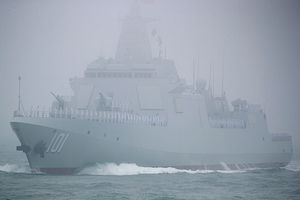China, it seems, can pull off its own offset strategy. A recent CNAS report by former Deputy Secretary of Defense Robert Work and Greg Grant recharacterizes the Third Offset (of which Work is generally recognized as a primary architect) as a strategy for disrupting China’s own offset strategy. The report describes the idea of an offset, and recounts the steps that China has take over the past thirty years to even the field with the United States.
Work and Grant relate a series of arguments that will be familiar to most of those who have followed the Chinese military over the last decade. They note that the size and sophistication of the Chinese economy is unmatched by previous U.S. competitors, and that consequently the United States faces a greater potential threat than it has suffered since the 19th century. However, while China’s potential was evident some thirty years ago, its military rise required careful, long-term planning. As the end of the Cold War disrupted the U.S.-China partnership, the Gulf War demonstrated the effectiveness of U.S. military technology, and the 1996 Taiwan Crisis made evident the tension in U.S.-China relations, China developed a long-range plan for parity, and supremacy.
With respect to the Chinese offset strategy, Work and Grant characterize it as a five-step plan for deterring, then defeating the United States:
- Industrial Espionage: The acquisition of Western military and civilian technology and the integration of that technology into the Chinese defense industrial base.
- Systems Destruction Warfare: Disruption of the reconnaissance strike-complexes that underlie US military dominance.
- Pre-emption: Developing capabilities to destroy deployed U.S. forces on the initiation of hostilities.
- Reveal for deterrence, conceal for victory: Maintenance of secret capabilities that the United States cannot prepare for.
- Exploit AI as force multiplier: Recently added, the pursuit of global leadership in artificial intelligence in order to maximize the capabilities of military forces engage with the United States.
Offset strategies are about, well, offsetting the enduring advantages of a particular opponent. The first and second offsets, in the United States, proposed nuclear and technological solutions to offsetting Soviet numerical advantages. A question which animates a lot of this analysis is whether China is attempting to replicate U.S. capabilities, or attempting to offset U.S. capabilities. The answer can, for a while, be “both,” but there are inflection points at which China needed to decide what it wanted from its national security establishment. Work and Grant do not cover some of these points, such as the development of stealth fighter technology and the acquisition of aircraft carriers, both of which suggest China may have priorities other than offsetting the United States.
As noted, for many readers the report will offer nothing shockingly new; the U.S. analytical community has identified most of these themes in the past, and incorporated them into policy. The (possibly belated) efforts of the Obama and Trump administrations to stymie Chinese industrial espionage represent part of this, and the Third Offset another part. Nevertheless, the report is a good account of the thinking of one of the main architects of U.S. technology strategy about the Chinese challenge, and an excellent run down of Chinese acquisition and technology strategy since the 1990s.

































